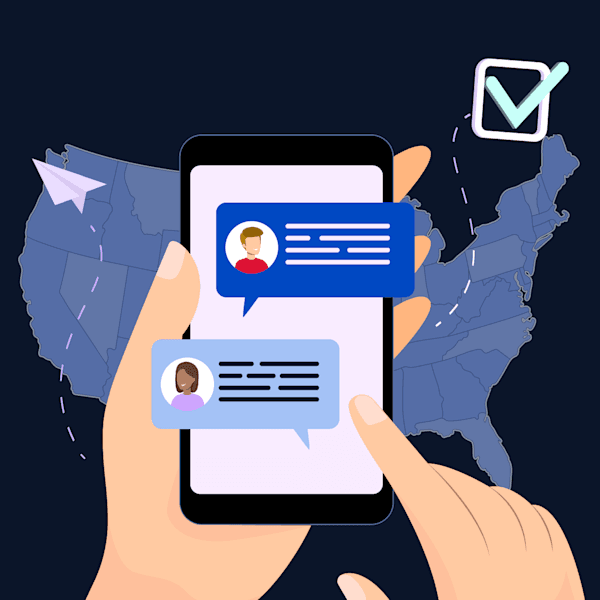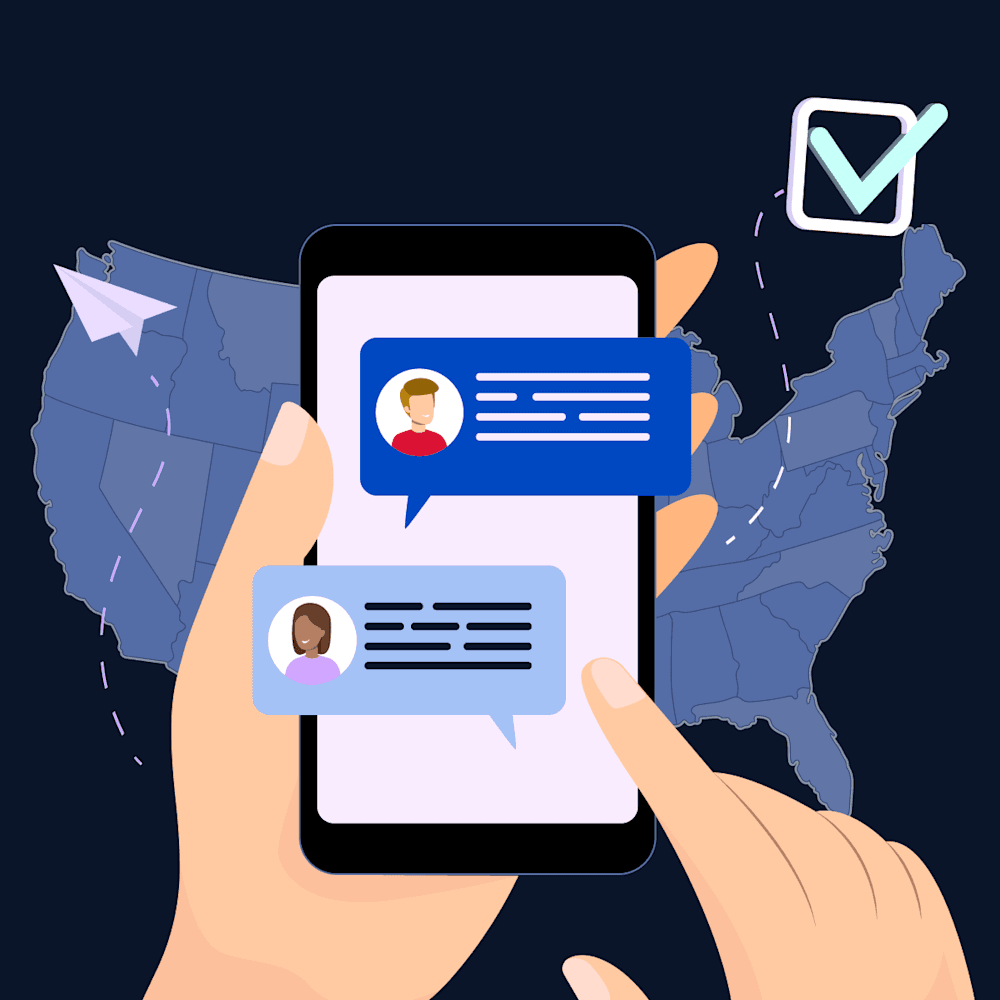
Voter Persuasion: In-Person vs. Digital Strategies
Voter persuasion is the art and science of moving people from undecided to supportive. For grassroots and Independent candidates, mastering persuasion is essential to building credibility, growing support, and winning tough races without party machinery or massive ad budgets.
Today’s campaigns don’t just persuade voters at their doorsteps. They do it online too, through social media, texts, emails, and digital ads. Both in-person and digital voter persuasion matter, and understanding how to adapt your approach across these spaces can help you connect with more people, more effectively.
This guide will break down what voter persuasion really means, compare in-person and digital methods, highlight key psychological factors that influence voter decisions, and share tips for combating misinformation in both real-world and digital conversations.
What Is Voter Persuasion?
Voter persuasion is the process of influencing how people think about you, your campaign, and the issues you represent. Unlike voter identification, which focuses on figuring out who already supports you, persuasion is about reaching those who are undecided or leaning toward another candidate.
At its core, persuasion is about building trust and offering voters a reason to believe that supporting you is in their best interest.
In-Person Voter Persuasion
In-person persuasion is still the gold standard for political outreach. Research from the Journal of Behavioral and Experimental Economics found that door-to-door campaigning can increase a candidate’s vote share by 3%. Considering local elections typically see very low voter turnout rates, an improvement of 3% can make a real difference in your campaign.
There are a few reasons why in-person voter persuasion works so effectively:
Personal Connection: Looking someone in the eye and listening to their concerns builds trust that digital messages can’t fully replicate.
Dialogue, Not Monologue: In-person conversations allow for back-and-forth. Voters can ask questions, and you can tailor your responses to their priorities.
Commitment Effect: When someone tells you face-to-face they’ll support you, they’re more likely to follow through and vote.
In-person persuasion efforts work because they feel real. When voters see that you’ve taken the time to show up, listen, and engage, it signals commitment and authenticity. That foundation of trust is what makes face-to-face methods so powerful, and it’s why your ground game is often the heart of your persuasion strategy.
LEARN MORE: See how to build a winning campaign field plan to maximize your in-person outreach efforts.
In-Person Voter Persuasion Methods
There’s no one-size-fits-all method for persuading voters face-to-face. Successful campaigns typically use a mix of methods to meet people where they are. Each tactic has its own strengths, but together they create a layered approach that builds familiarity and trust over time.
Canvassing
Door-to-door canvassing is the most direct and personal form of persuasion. It allows you to meet voters where they live, show up consistently, and demonstrate your commitment to the community.
Best practices include:
Training volunteers to listen as much as they talk.
Asking open-ended questions to uncover voter priorities.
Leaving behind campaign literature as a reminder.
Canvassing sets the tone for grassroots campaigns because it shows voters you’re willing to invest time and energy in their community.
Community Events & House Parties
Local gatherings, from BBQs to town halls, allow for small-group persuasion. These events build rapport in a relaxed setting and let voters see your authenticity outside of a formal campaign script.
Best practices include:
Encouraging two-way dialogue rather than just giving speeches.
Creating space for volunteers and supporters to share why they back you.
Following up with attendees after the event to deepen connections.
Events like these transform casual conversations into lasting relationships, which is the essence of persuasion.
LEARN MORE: Learn how to plan and host house parties for your campaign.
Phone Banking
Even though phone calls aren’t face-to-face, they still count as personal and direct live outreach. Volunteer-driven phone banks let you scale conversations and reach people you might miss at the doors.
Best practices include:
Using voter lists to prioritize undecided or first-time voters.
Training volunteers to listen carefully and log responses.
Keeping calls short, conversational, and respectful of people’s time.
A well-run phone bank keeps your campaign connected to voters at scale without sacrificing the personal touch.
Literature Drops & Visibility Efforts
Dropping campaign literature at voters’ front doors, staffing tables at farmers' markets, or showing up at parades and fairs increases name recognition while opening the door for conversation.
Best practices include:
Pairing literature drops with live outreach whenever possible.
Making materials easy to scan, with a photo, short message, and clear call-to-action.
Wearing campaign gear to increase visibility at public events.
These visibility efforts keep your name top-of-mind and make voters more receptive when they encounter your campaign in other ways.
One-on-One Meetings
Sometimes the most persuasive contact happens in a quieter setting, such as over coffee with a community leader or at a sit-down with a small group of undecided voters. These one-on-ones can build deep trust and win long-term allies.
Best practices include:
Preparing with background knowledge about the person or group.
Asking thoughtful questions and really listening to concerns.
Following up with a personal thank-you or additional resources..
One-on-ones are especially powerful for turning influencers and community leaders into advocates for your campaign.
Digital Voter Persuasion
Digital persuasion has exploded in importance, particularly for grassroots campaigns that need to scale outreach quickly and affordably. Over 250 million Americans use social media, so while some campaign digital marketing tactics may lack the intimacy of in-person contact, online efforts offer reach and repetition at a scale that’s unattainable for traditional canvassing.
Some reasons digital voter persuasion is effective:
Scalability: A single text blast, email, or TikTok post can reach thousands at once.
Accessibility: Digital outreach helps you connect with voters who may be harder to reach in person, like younger voters or those in rural areas.
Data-Driven Targeting: Digital platforms allow you to target specific demographics or interest groups with tailored messages.
Digital persuasion works best when it feels authentic, not transactional. Voters are bombarded with online content every day, so what stands out are messages that reflect real values and invite real connection. By pairing reach with relevance, digital strategies can turn fleeting interactions into lasting impressions.
LEARN MORE: Explore some proven political digital marketing strategies to power your campaign’s online outreach.
Digital Voter Persuasion Methods
Strong campaigns use a mix of digital channels alongside in-person efforts to share their message, reach different audiences, and reinforce what voters are hearing in person. Each digital voter outreach method works differently, but together they create a steady drumbeat of visibility and engagement.
Social Media
Social media platforms let you tell your story, share your values, and reach voters where they already spend time. According to recent surveys, 54% of Americans often or sometimes get their news about local politics from social media, and over 70% of adults aged 18 to 29 often or sometimes get their political news from various social platforms. So, if you skip making a social media outreach strategy, you’re essentially leaving votes on the table.
Best practices include:
Posting consistently with a mix of personal stories, policy positions, and community updates.
Engaging directly with comments and questions to show authenticity.
Using visuals, like photos, videos, and graphics, to make your message memorable.
Social media is most persuasive when it feels personal and interactive, not like a press release.
Texting & Email
Texts and emails provide more direct, one-on-one contact than social media. They’re also easy to personalize and track.
Best practices include:
Using peer-to-peer texting to start real conversations.
Keeping emails short, clear, and action-oriented.
Following up multiple times across the campaign to build recognition.
Well-timed texts and email messages can cut through the noise and feel like a personal nudge from your campaign.
LEARN MORE: See how you can get free texts to jump-start your campaign’s texting outreach strategy.
Digital Advertising
Digital advertising amplifies visibility and allows you to target specific groups with tailored messages. They’re especially useful in the weeks leading up to election day.
Best practices include:
Keeping ad copy simple and values-driven.
Using A/B testing to see which messages resonate best.
Pairing ads with organic outreach to reinforce your message.
Political advertising works best when it mirrors the authentic content you’re sharing elsewhere.
Video Content & Online Events
From short TikTok clips to livestream Q&As, video helps voters see and hear from you directly, even if you can’t be in the same room.
Best practices include:
Keeping videos short, authentic, and easy to share.
Using live formats to answer voter questions in real time.
Repurposing video clips across multiple platforms for maximum reach.
Video content brings your campaign to life online, creating a sense of connection that static posts can’t match.
Psychological Factors That Influence Voter Persuasion
Whether online or in person, political persuasion is rooted in psychology.
Here are a few key factors to keep in mind:
Social Proof: Voters are more likely to support you if they see friends, neighbors, or community leaders doing the same.
Reciprocity: Listening first and acknowledging concerns makes people more receptive to your message.
Consistency: Repeated contact across multiple channels builds familiarity and trust.
Emotion Before Facts: Data is important, but stories are often more persuasive than statistics. Lead with values and human impact.
By grounding your outreach in human psychology, you make every conversation and every message more impactful.
LEARN MORE: Understand the psychology behind voting.
Combating Misinformation in Voter Persuasion
Misinformation spreads both online and offline, and candidates need strategies for addressing it without amplifying it.
In-Person Strategy: If a voter brings up a false claim at the door, listen calmly, acknowledge their concern, and redirect to facts that reinforce your campaign’s credibility. Avoid repeating misinformation verbatim.
Digital Strategy: Correct falsehoods with clear, concise, and positive messaging. Share links to credible sources and encourage supporters to amplify accurate information.
Don’t wait to play defense. Use your campaign’s digital platforms and in-person outreach to share your message early and often, making it harder for misinformation to take root.
Adapting Your Approach: The Hybrid Persuasion Strategy
The best campaigns don’t choose between in-person and digital voter persuasion. They combine them.
For example:
Knock on a voter’s door, then send them a follow-up text the next week.
Host a house party, then share photos and testimonials on social media.
Answer a voter’s question online, then invite them to meet in person at a community event.
By weaving together in-person and digital strategies, you maximize your reach, build stronger relationships, and create a campaign that feels both accessible and authentic.
Start small, stay consistent, and remember: voters don’t just want to be persuaded. They want to be heard.
GoodParty.org’s free campaign tools empower Independent candidates and help them master persuasion with data-driven voter reports, texting support, and templates designed to make outreach more effective. With the right tools and a clear plan, you can cut through the noise, connect with voters, and earn their trust.
Photo by RDNE Stock project
Book a free demo today to see how GoodParty.org can help you win votes and build a strong, people-powered campaign.

